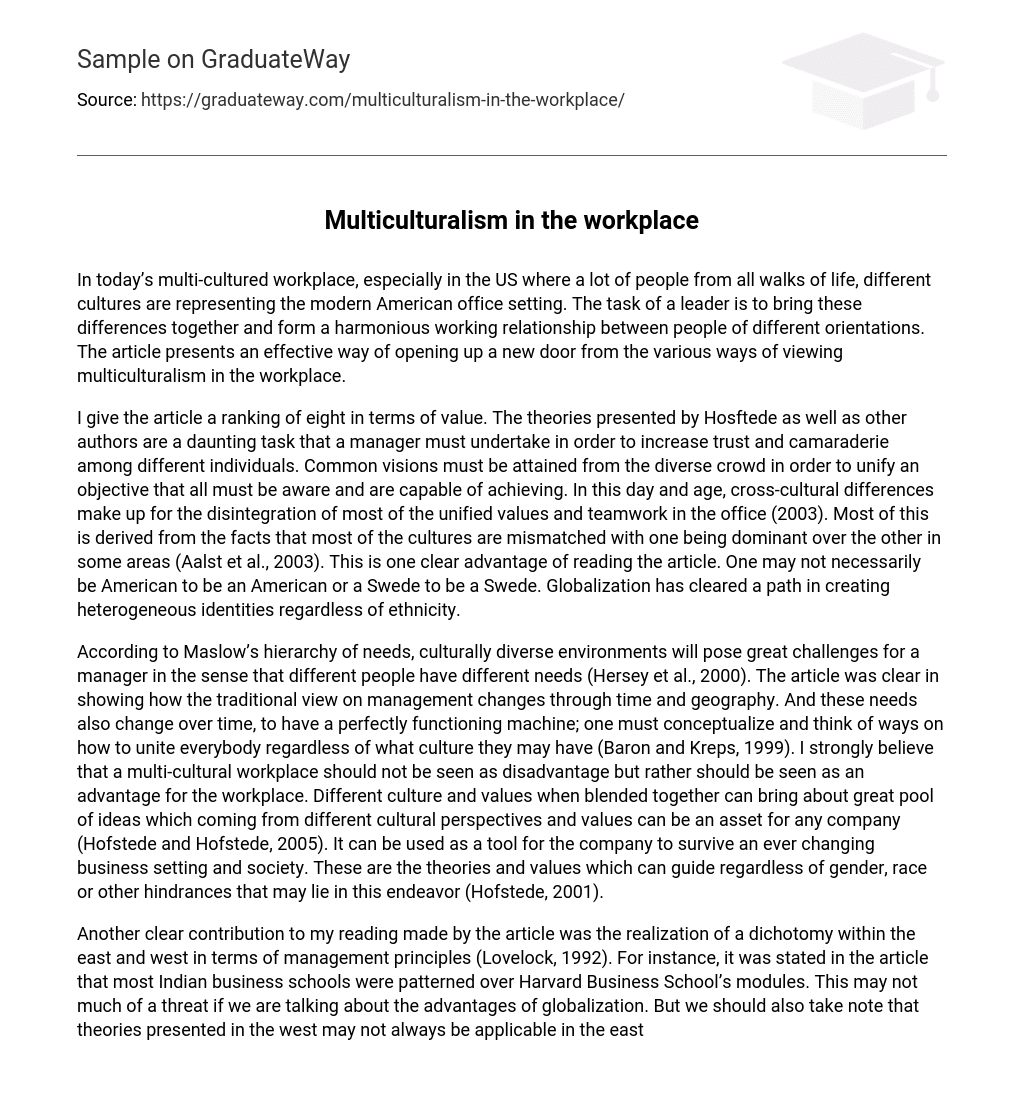In today’s multi-cultured workplace, especially in the US where a lot of people from all walks of life, different cultures are representing the modern American office setting. The task of a leader is to bring these differences together and form a harmonious working relationship between people of different orientations. The article presents an effective way of opening up a new door from the various ways of viewing multiculturalism in the workplace.
I give the article a ranking of eight in terms of value. The theories presented by Hosftede as well as other authors are a daunting task that a manager must undertake in order to increase trust and camaraderie among different individuals. Common visions must be attained from the diverse crowd in order to unify an objective that all must be aware and are capable of achieving. In this day and age, cross-cultural differences make up for the disintegration of most of the unified values and teamwork in the office (2003). Most of this is derived from the facts that most of the cultures are mismatched with one being dominant over the other in some areas (Aalst et al., 2003). This is one clear advantage of reading the article. One may not necessarily be American to be an American or a Swede to be a Swede. Globalization has cleared a path in creating heterogeneous identities regardless of ethnicity.
According to Maslow’s hierarchy of needs, culturally diverse environments will pose great challenges for a manager in the sense that different people have different needs (Hersey et al., 2000). The article was clear in showing how the traditional view on management changes through time and geography. And these needs also change over time, to have a perfectly functioning machine; one must conceptualize and think of ways on how to unite everybody regardless of what culture they may have (Baron and Kreps, 1999). I strongly believe that a multi-cultural workplace should not be seen as disadvantage but rather should be seen as an advantage for the workplace. Different culture and values when blended together can bring about great pool of ideas which coming from different cultural perspectives and values can be an asset for any company (Hofstede and Hofstede, 2005). It can be used as a tool for the company to survive an ever changing business setting and society. These are the theories and values which can guide regardless of gender, race or other hindrances that may lie in this endeavor (Hofstede, 2001).
Another clear contribution to my reading made by the article was the realization of a dichotomy within the east and west in terms of management principles (Lovelock, 1992). For instance, it was stated in the article that most Indian business schools were patterned over Harvard Business School’s modules. This may not much of a threat if we are talking about the advantages of globalization. But we should also take note that theories presented in the west may not always be applicable in the east (Schein, 1987). A manager should also be able to take note of local traditions and cultures which may affect the end result of any good theory there is (Storey and Sisson, 1993). The problem in Indian business schools is that they take it as it is and does not modify according to their Hindu culture.
However, one may not be able to notice the natural bias of Hofstede in terms of religious constraints and how this affects the workplace. This particular angle limits the arguments of Hofstede in the lightest sense. Religious constraints thereby becomes one limitation of this article as well as the absence of a substantial example whereas a multi-cultural company was able to successfully apply the theories of Hofstede without sacrificing profitability and the needs of the workforce.
References:
(2003) Dictionary of human resources and personnel amangement, Bloomsbury.
AALST, W. V. D., TER HOFSTEDE, A. & WESKE, M. (2003) Business process management : international conference, BPM 2003, Eindhoven, the Netherlands, June 26-27, 2003 : proceedings, Berlin ; New York, Springer.
BARON, J. N. & KREPS, D. M. (1999) Strategic human resources: frameworks for general managers, New York, Wiley.
HERSEY, P., BLANCHARD, K. H. & JOHNSON, D. E. (2000) Management of organizational behavior: leading human resources, Upper Saddle River, NJ, Prentice Hall.
HOFSTEDE, G. H. (2001) Culture’s consequences : comparing values, behaviors, institutions, and organizations across nations, Thousand Oaks, Calif., Sage Publications.
HOFSTEDE, G. H. & HOFSTEDE, G. J. (2005) Cultures and organizations : software of the mind, New York, McGraw-Hill.
LOVELOCK, C. H. (1992) Managing services: marketing, operations and human resources, Prentice-Hall.
SCHEIN, E. H. (1987) The art of managing human resources, Oxford University Press.
STOREY, J. & SISSON, K. (1993) Managing human resources and industrial relations, Buckingham, Open University Press.





